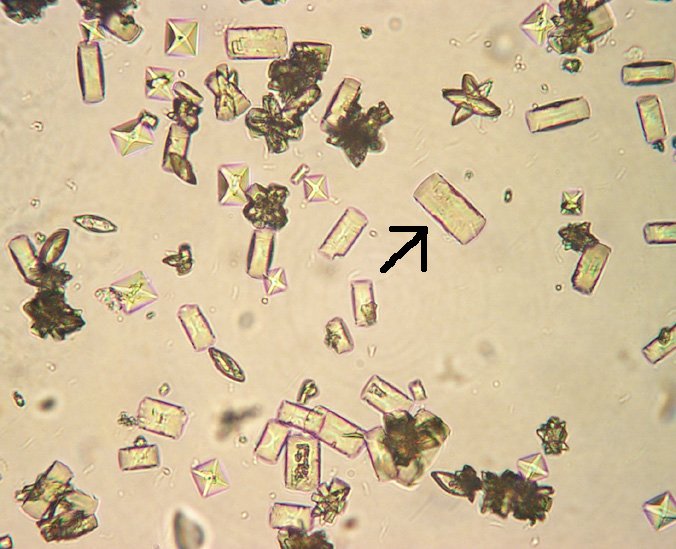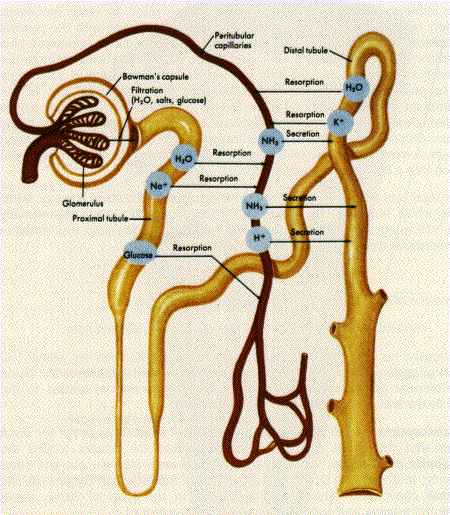جوري
Soldier Through It!
- Messages
- 27,759
- Reaction score
- 6,095
- Gender
- Female
- Religion
- Islam
picking up where we left off
A man is admitted to the hospital with renal failure developing over a few days
his cr has risen from 0.8mg/dl to 2.5 mg/dl. His bun has risen even more, going from 15 to 54. his serum bicarbonate is slightly low. the urine sodium is low and the urine osmolality is high..
1-Blood pressure 92/56 and pulse is 124.
2-serum albumin is 2.2 and the PT is elevated. there is splenomegaly
3-Ha has an ejection fraction of 24% with edema. a diuretic was recently started.
4-a bruit is present at the flanks and he has just started an ACE inhibitor.
1- pre-renal azoremia from any cause leads to an elevation of the BUN and CR, wit the BUN rising more than the CR in a ratio greater than 15:1. The tachycardia and hypotension in the first case suggest hypovolemia or any other form of chock. FeNa <1% also indicated a pre-renal etiology.
2- low oncotic pressure for any reason results in pre-renal azotemia because of decreased renal perfusion. In addition, liver dz such as cirrhosis can lead to hepatorenal syndrome, which is renal failure entirely based on liver failure.
3-CHF from any cause leads to rpe-renal azotemia. It can become suddenly worse with the volume depletion from a diuretic. pre-renal azotemia leads to low urine sodium and high urine osmolality
4- Renal artery stenosis is associated with decreased renal perfusion. ACE inhibitors can precipitate acute renal failure. Think about fibromuscular dysplasia in a young woman.
_____________________________________________
pt with worsening renal function over the past few days. His cr is 3.5md/dL and the BUN is 28 units. The urine Sodium is 45meg/L and the urine osmolality is 290 mosm/L. His serum bicarbonate is low.
1- pt has been on gentamicin for last 8 days
2-he was on pipercillin for a few days. but stopped yesterday. He has fever and rash and there are eosinophils in his urine.
3-Chemotherapy for lymphoma was started 2 days ago
4- there is an empty bottle of anti-freeze by his bedside..
1-aminoglycoside induced RF generally occurs after 5-10 days of exposure to the medication. As with all forms of acute tubular necrosis, the BUN and CR will rise in about 10:1 ratio.
the urine sodium will be high (>40) and the urine osmolality will be low (<350) because of the inability of the damaged kidney tubules to concentrate urine . Amphotercin and any other renal toxic meds will result in the same numbers.
2- Allergic interstitial nephritis presents with fever, rash and eosinophils in the urine. The presence of esosinophils in the urine is more frequently than in the blood.
3- Hyperuricemia from tumor lysis syndrome will lead to acute RF
4-Antifreeze contains ethylene glycol, which leads to acute RF from oxalic acid accumulation in the kidney tubule. Look for 'envelope shaped oxalate crystals' in the urine. Formic acid accumulates with methanol ingestion and causes blindness.
____________________________________________
a man comes to the ER dept after sustaining a prolonged seizure. He has dark urine which is strongly positive on the dipstick for blood but in which no red cells are seen on microscopic exam. His serum bicarb level is low.
Rhabomyolysis presents after crush injury or severe exertion of any kind with dark urine in the absence of visible red cells. This is indicative of urine myoglobin. Rhbdomyolysis leads to metabolic acidosis, hyperkalemia and eventually renal failure.
2- Urine myoglobin is the most specific diagnostic test for rhbadomyolysis. The potassium level and EKG are probably the most urgent diagnostic steps because they determine who is most likely to die. the CPK level will be significantly elevated. admin of IV fluids and alkalinazation of the urine are important. an elevated CPK is not specific ofor indicating the cause of renal failure.
__________________________________________________
pt with confusion. His sodium is at a low 122 mEq/L he has no edema, clear lungs, and no JVD. There is no orthostasis.
1- pt has lung ca with mets to brain. Urine Sodium is 70 (high) and urine osmolarity is 450 high.
2-the pt is bipolar, with frequent urination all day and less at night. urine sodium is 10 low and urine osmolarity is 75 low.
3- the pt has diabetes with a glucose level of 850 (NL 80-110)
here are some lab values for reference
SIADH is caused by an abnormality of the brain or the lungs. This can be a cancer, infarction or infection. SIADH is associated with an inappropriately high urine sodium and osmolarity. The normal response to a low serum sodium should be a low urine sodium and low urine osmolarity. SIADH is a case of euvolemic hyponatremia. Free water restriction is the treatment .
2-psycogenic polydipsia is associated with bipolar disorder. there is a normal urinary response to hyponatremia. The normal response is low urine sodium and osmolality. decrease in sx at night is the key to the dx. when he goes to sleep he stops drinking, so he stops urinating.
3- pseudohyponatremia is from an elavted glucose for any reason. For every increase in glucose of 100 above normal there is a 1.6pt decrease in sodium.
___________________________________
A man is admitted to the hospital with renal failure developing over a few days
his cr has risen from 0.8mg/dl to 2.5 mg/dl. His bun has risen even more, going from 15 to 54. his serum bicarbonate is slightly low. the urine sodium is low and the urine osmolality is high..
1-Blood pressure 92/56 and pulse is 124.
2-serum albumin is 2.2 and the PT is elevated. there is splenomegaly
3-Ha has an ejection fraction of 24% with edema. a diuretic was recently started.
4-a bruit is present at the flanks and he has just started an ACE inhibitor.
1- pre-renal azoremia from any cause leads to an elevation of the BUN and CR, wit the BUN rising more than the CR in a ratio greater than 15:1. The tachycardia and hypotension in the first case suggest hypovolemia or any other form of chock. FeNa <1% also indicated a pre-renal etiology.
2- low oncotic pressure for any reason results in pre-renal azotemia because of decreased renal perfusion. In addition, liver dz such as cirrhosis can lead to hepatorenal syndrome, which is renal failure entirely based on liver failure.
3-CHF from any cause leads to rpe-renal azotemia. It can become suddenly worse with the volume depletion from a diuretic. pre-renal azotemia leads to low urine sodium and high urine osmolality
4- Renal artery stenosis is associated with decreased renal perfusion. ACE inhibitors can precipitate acute renal failure. Think about fibromuscular dysplasia in a young woman.
_____________________________________________
pt with worsening renal function over the past few days. His cr is 3.5md/dL and the BUN is 28 units. The urine Sodium is 45meg/L and the urine osmolality is 290 mosm/L. His serum bicarbonate is low.
1- pt has been on gentamicin for last 8 days
2-he was on pipercillin for a few days. but stopped yesterday. He has fever and rash and there are eosinophils in his urine.
3-Chemotherapy for lymphoma was started 2 days ago
4- there is an empty bottle of anti-freeze by his bedside..
1-aminoglycoside induced RF generally occurs after 5-10 days of exposure to the medication. As with all forms of acute tubular necrosis, the BUN and CR will rise in about 10:1 ratio.
the urine sodium will be high (>40) and the urine osmolality will be low (<350) because of the inability of the damaged kidney tubules to concentrate urine . Amphotercin and any other renal toxic meds will result in the same numbers.
2- Allergic interstitial nephritis presents with fever, rash and eosinophils in the urine. The presence of esosinophils in the urine is more frequently than in the blood.
3- Hyperuricemia from tumor lysis syndrome will lead to acute RF
4-Antifreeze contains ethylene glycol, which leads to acute RF from oxalic acid accumulation in the kidney tubule. Look for 'envelope shaped oxalate crystals' in the urine. Formic acid accumulates with methanol ingestion and causes blindness.
____________________________________________
a man comes to the ER dept after sustaining a prolonged seizure. He has dark urine which is strongly positive on the dipstick for blood but in which no red cells are seen on microscopic exam. His serum bicarb level is low.
Rhabomyolysis presents after crush injury or severe exertion of any kind with dark urine in the absence of visible red cells. This is indicative of urine myoglobin. Rhbdomyolysis leads to metabolic acidosis, hyperkalemia and eventually renal failure.
2- Urine myoglobin is the most specific diagnostic test for rhbadomyolysis. The potassium level and EKG are probably the most urgent diagnostic steps because they determine who is most likely to die. the CPK level will be significantly elevated. admin of IV fluids and alkalinazation of the urine are important. an elevated CPK is not specific ofor indicating the cause of renal failure.
__________________________________________________
pt with confusion. His sodium is at a low 122 mEq/L he has no edema, clear lungs, and no JVD. There is no orthostasis.
1- pt has lung ca with mets to brain. Urine Sodium is 70 (high) and urine osmolarity is 450 high.
2-the pt is bipolar, with frequent urination all day and less at night. urine sodium is 10 low and urine osmolarity is 75 low.
3- the pt has diabetes with a glucose level of 850 (NL 80-110)
here are some lab values for reference
http://www.globalrph.com/labs.htmAlbumin 3.2 - 5 g/dl
Alkaline phosphatase (Adults: 25-60) 33 - 131 IU/L
Adults > 61 yo: 51 - 153 IU/L
Ammonia 20 - 70 mcg/dl
Bilirubin, direct 0 - 0.3 mg/dl
Bilirubin, total 0.1 - 1.2 mg/dl
Blood Gases
Arterial Venous
pH 7.35 - 7.45 7.32 - 7.42
pCO2 35 - 45 38 - 52
pO2 70 - 100 28 - 48
HCO3 19 - 25 19 - 25
O2 Sat % 90 - 95 40 - 70
BUN 7 - 20 mg/dl
Complete blood count (CBC) Adults
Male
Female
Hemoglobin (g/dl) 13.5 - 16.5 12.0 - 15.0
Hematocrit (%) 41 - 50 36 - 44
RBC's ( x 106 /ml) 4.5 - 5.5
4.0 - 4.9
RDW (RBC distribution width) < 14.5
MCV 80 - 100
MCH 26 - 34
MCHC % 31 - 37
Platelet count 100,000 to 450,000
Creatinine kinase (CK) isoenzymes
CK-BB 0%
CK-MB (cardiac) 0 - 3.9%
CK-MM 96 - 100%
Creatine phosphokinase (CPK) 8 - 150 IU/L
Creatinine (mg/dl) 0.5 - 1.4
Electrolytes
Calcium 8.8 - 10.3 mg/dL
Calcium, ionized 2.24 - 2.46 meq/L
Chloride 95 - 107 mEq/L
Magnesium 1.6 - 2.4 mEq/L
Phosphate 2.5 - 4.5 mg/dL
Potassium 3.5 - 5.2 mEq/L
Sodium 135 - 147 mEq/L
Ferritin (ng/ml) 13 - 300
Folate (ng/dl) 3.6 - 20
Glucose, fasting (mg/dl) 60 - 110
Glucose (2 hours postprandial) (mg/dl) Up to 140
Hemoglobin A1c 6-8
Iron (mcg/dl) 65 - 150
Lactic acid (meq/L) 0.7 - 2.1
LDH (lactic dehydrogenase) 56 - 194 IU/L
Lipoproteins and triglycerides
Cholesterol, total < 200 mg/dl
HDL cholesterol 30 - 70 mg/dl
LDL cholesterol 65 - 180 mg/dl
Triglycerides 45 - 155 mg/dl (< 160)
Osmolality 289 - 308 mOsm/kg
SGOT (AST) < 35 IU/L (20-48)
SGPT (ALT) <35 IU/L
Thyroid Function tests
Free T3 2.3-4.2 pg/ml
Serum T3 70-200 ng/dl
Free T4 0.5-2.1 ng/dl
Serum T4 4.0-12.0 mcg/dl
TSH 0.25-4.30 microunits/ml
Total iron binding capacity (TIBC) 250 - 420 mcg/dl
Transferrin > 200 mg/dl
Uric acid (male) 2.0 - 8.0 mg/dl
(female) 2.0 - 7.5 mg/dl
WBC + differential
WBC (cells/ml) 4,500 - 10,000
Segmented neutrophils 54 - 62%
Band forms 3 - 5% (above 8% indicates left shift)
Basophils 0 - 1 (0 - 0.75%)
Eosinophils 0 - 3 (1 - 3%)
lymphocytes 24 - 44 (25 - 33%)
Monocytes 3 - 6 (3 - 7%)
Laboratory test
Values if prerenal cause of acute renal failure
Values if intrarenal cause of acute renal failure
FENa, percent*
<1
>1
BUN to creatinine ratio
>20:1
10 to 20:1
Urine specific gravity
>1.020
1.010 to 1.020
Urine osmolality, mOsm per kg
>500
300 to 500
Urine sodium concentration, mEq per L (mmol per L)
<10 (10)
>20 (20)
Urine sediment
Hyaline casts
Granular casts
FENa = fractional excretion of sodium; BUN = blood urea nitrogen.
*-FENa is calculated as follows:
FENa =
Urine sodium ÷ plasma sodium X 100
SIADH is caused by an abnormality of the brain or the lungs. This can be a cancer, infarction or infection. SIADH is associated with an inappropriately high urine sodium and osmolarity. The normal response to a low serum sodium should be a low urine sodium and low urine osmolarity. SIADH is a case of euvolemic hyponatremia. Free water restriction is the treatment .
2-psycogenic polydipsia is associated with bipolar disorder. there is a normal urinary response to hyponatremia. The normal response is low urine sodium and osmolality. decrease in sx at night is the key to the dx. when he goes to sleep he stops drinking, so he stops urinating.
3- pseudohyponatremia is from an elavted glucose for any reason. For every increase in glucose of 100 above normal there is a 1.6pt decrease in sodium.
___________________________________











